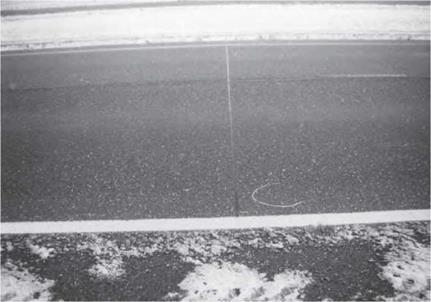DEVELOPMENT OF AASHTO PAVEMENT DESIGN EQUATIONS
Perhaps the most widely used pavement design method in the United States and throughout the world is that presented in the AASHTO Guide for Design of Pavement Structures. A long history of pavement studies has led to the current (1993 with 1998 supplement) edition.
|
FIGURE 3.8 Joint in composite pavement that has been sawed and sealed. |
The developments leading to the current AASHTO design procedure began with the Bates Experimental Road, which was constructed in 1922 near Springfield, Illinois. The purpose of the experimental road was to determine what factors affected pavement performance. The researchers found that pavement performance could be correlated with truck loading. No further major research was conducted over the ensuing 25 years.
The changes in truck configuration and expansion of the highway network resulting from World War II brought pavement performance to the forefront again. In 1949, the Council of State Governments held a meeting in Columbus, Ohio. At this meeting, highway officials decided there was a “need for more factual data concerning the effects of axle loads of various magnitudes on pavements.” The effort to advance the science of pavement design was led by the American Association of State Highway Officials (AASHO, which later became AASHTO). The regional AASHO associations decided to construct test pavements in each region. The first of these test roads was constructed by the Southeastern AASHO states. Named Road Test One, two test loops were constructed in 1950 near La Plata, Maryland, each loop containing two 12-ft-wide (3.7-m) pavement lanes. All sections constructed were concrete with a pavement thickness of 7 in (178 mm) thickening to 9 in (229 mm) at the edge of the pavement. Each lane of a loop carried only one loading and axle configuration.
A second regional test road was constructed by the Western Association of State Highway Organizations (WASHO). Named the WASHO Road Test, two test loops were constructed in 1952 near Malad, Idaho, each consisting of two 12-ft (3.7-m) lanes. All pavement was comprised of asphalt concrete on a crushed aggregate base, constructed on subbases from 0 to 16 in (406 mm) thick. Each lane of a loop carried only one loading and axle configuration. Because of the limited number of sections constructed in Maryland and Idaho, a rational design procedure could not be developed.
In 1951, support was growing within AASHO for an expanded road test. This led to the construction of the AASHO Road Test near Ottawa, Illinois, which contained six loops with two 12-ft (3.7-m) lanes. The AASHO Road Test contained 468 asphalt sections and 368 concrete sections. Each lane of a loop carried only one loading and axle configuration. A total of 1,114,000 load applications were applied over a 2-year period.
The rigid pavements in the AASHO Road Test were concrete slabs ranging in thickness from 2lA to 121/2 in (63 to 317 mm) thick. The slabs were placed either on a granular subbase or directly on the subgrade. Flexible pavements at the AASHO Road Test consisted of asphalt pavements placed on a base and/or subbase. As confirmed by these tests, rigid pavements carry traffic loads through beam action whereas flexible pavements carry traffic loads by spreading the stress through the underlying layers.
Unpublished preliminary results from the road test were released to the states in 1961 and 1962. The AASHO Interim Guide for Design of Pavement Structures was published in 1972. Chapter 3 of the interim guide was revised in 1981. The first edition of the AASHTO Guide for Design of Pavement Structures (1986) introduced many new concepts including the reliability concept. It was published in two volumes, the first giving design procedures and the second providing documentation and explanatory information. The second edition of the guide was published in 1993 and a supplement in 1998.







Leave a reply